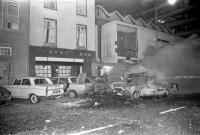Dublin Bombs, 1972
Published in 20th-century / Contemporary History, Features, Issue 6 (Nov/Dec 2012), Troubles in Northern Ireland, Volume 20
Just before 8pm on Friday 1 December 1972 a car bomb exploded at Eden Quay, beside Liberty Hall, injuring dozens of people and causing extensive damage. (Irish Times/Paddy Whelan)
Just before 8pm on Friday 1 December 1972 a car bomb exploded at Eden Quay, beside Liberty Hall, injuring dozens of people and causing extensive damage. Fifteen minutes later there was another explosion at Sackville Place, killing George Bradshaw (30) and Thomas Duffy (23). Bradshaw was a bus driver, while Duffy was a conductor. Both men had left the CIE canteen on Marlborough Street just moments before. A witness described the aftermath:
‘There was a large pall of smoke hanging over the area of the blast. At least six cars were on fire . . . there were people strewn all over the street. One man was lying unconscious in a pool of blood from his legs . . . everywhere there was sobbing and screaming . . . people were running in all directions.’
Over 130 people were injured in the two incidents. But the bombs did not just cause death and destruction; they also literally blasted into law controversial new measures. That night the Dáil was debating proposed changes to the Offences Against the State Act. The Fianna Fáil government was attempting to add new clauses to already strict security legislation. These would allow for suspects to be held for up to a week on the word of a senior Garda officer on suspicion of involvement in subversion. The bill was opposed by the Labour Party, the trade unions and a broad range of opinion, including, initially, most Fine Gael TDs. The Irish Transport and General Workers Union asserted that while it ‘opposed political violence which is directed at civilians, we are equally opposed to the violence that is being done by the government to democratic institutions and civilised legal procedures’. Fears about the misuse of state power had increased dramatically when on 19 November RTÉ journalist Kevin O’Kelly was jailed for refusing to hand over the tape of an interview with Provisional IRA leader Seán Mac Stiofáin to Gardaí. (Gardaí had arrested MacStiofáin shortly after he left O’Kelly’s home, where the interview had taken place.) The government then dismissed the RTÉ authority for allowing the station to broadcast O’Kelly’s interview with MacStiofáin. In response, journalists undertook a 24-hour strike, forcing all three daily newspapers to shut. Among those incensed by the interference in the press was journalist Kevin Myers, who resigned from RTÉ in protest at increasing censorship. Dublin was already on edge in the run up to the Dáil debate. Following his arrest, MacStiofáin had refused to recognise the court and was sentenced to six months in jail. He then embarked on a hunger and thirst strike in Mountjoy. There were real fears that he was likely to die and street protests increased as his fast progressed. Daily demonstrations took place outside the prison, while workers staged unofficial strikes and walk-outs demanding his release. MacStiofáin was moved for health reasons to the nearby Mater Hospital; the IRA attempted to rescue him but were thwarted after a shoot-out in which several people were injured. MacStiofáin was then transferred to the Curragh military prison. (He later abandoned the thirst strike but remained on hunger strike for 57 days.) In the midst of the turmoil, during the early hours of Sunday 26 November a bomb blast at the Irish Film Centre on Burgh Quay injured dozens of people. It was presumed that republicans were responsible and the government argued that this proved that harsh measures were needed to secure order. Despite these concerns over security, the majority of Fine Gael TDs looked set to vote with Labour and others to defeat the bill. If defeated, Fianna Fáil were then expected to have to call a general election. As the bill was debated, some 5,000 people demonstrated outside Leinster House, which was being guarded by 1,000 Gardaí and several hundred troops. The explosions on the other side of the Liffey were heard inside the Dáil chamber. In this frenzied atmosphere most Fine Gael TDs abstained on the vote, allowing the bill to pass. The government had won an unlikely victory. There was no doubt that the bombs changed the course of legal and political history. As the Irish Transport Union’s paper Liberty stated, the new laws had been
‘. . . born in the tragedy of death, injury and destruction and the double talk of confused politicians who have put party before country and made nonsense of our democratic institutions . . . the passage of the bill was assured by the two bomb blasts in Dublin on Friday night.’
No organisation claimed responsibility and the bombers were never caught. Senior members of the Ulster Volunteer Force from Belfast were suspected of organising the attacks. But speculation has raged ever since as to the extent of the involvement of British intelligence services in collusion with Loyalists in these and later explosions. HI
Brian Hanley lectures in history at University College Dublin.
Further reading:
J. Bowyer Bell, In dubious battle: the Dublin and Monaghan bombings 1972–1974 (Dublin, 1996).D. Dunne & G. Kerrigan, Round up the usual suspects (Dublin, 1984).D. Ó Beacháin, The destiny of the soldiers: Fianna Fáil, Irish Republicanism and the IRA 1926–1973 (Dublin, 2010).J. Tiernan, The Dublin and Monaghan bombings (Dublin, 2003).
















